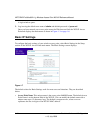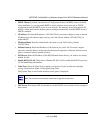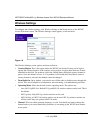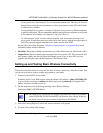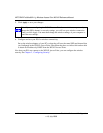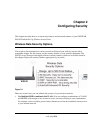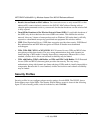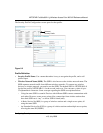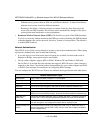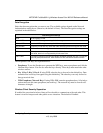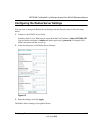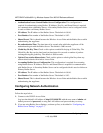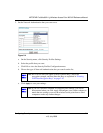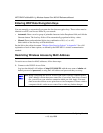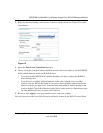
NETGEAR ProSafe 802.11g Wireless Access Point WG102 Reference Manual
2-4 Configuring Security
v1.0, July 2008
– Different access points within an ESS can use different channels. To reduce interference,
adjacent access points should use different channels.
– Roaming is the ability of wireless stations to connect wirelessly when they physically
move from one ESS to another. The wireless station automatically changes to the access
point with the least interference or best performance.
• Broadcast Wireless Network Name (SSID). This field lets you turn off the SSID broadcast.
If you do so, then only stations that know the SSID can connect. Disabling the SSID broadcast
somewhat hampers the wireless network ‘discovery’ feature of some products. The default is
to enable SSID broadcast.
Network Authentication
The WG102 Access Point is set by default as an open system with no authentication. When setting
up Network Authentication, bear in mind the following:
• If you are using Access Point mode, then all options are available. In other modes such as
Repeater or Bridge, some options may be unavailable.
• Not all wireless adapters support WPA or WPA2. Windows XP and Windows 2000 with
Service Pack 3 do include the client software that supports WPA. However, client software is
required on the client. Consult the product documentation for your wireless adapter and WPA
or WPA2 client software for instructions on configuring WPA2 settings.
You can configure the WG102 Access Point to use authentication types shown in the table below.
Network Authentication Types
Open System Can be used with WEP encryption, or no encryption.
Shared Key WEP must be used. At least one shared key must be entered.
Legacy 802.1x: You must configure the Radius Server Settings to use this option.
WPA-PSK You must use TKIP encryption, and enter the WPA passphrase (Network key).
WPA with Radius You must configure the Radius Server Settings to use this option.
WPA2-PSK WPA2 is a newer version of WPA. Select this only if all clients support WPA2. With
WPA2, you must use AES encryption, and enter the WPA passphrase (Network key).
WPA-PSK and
WPA2-PSK
Clients can use either WPA (with TKIP) or WPA2 (with AES). If selected, encryption
must be TKIP + AES. The WPA passphrase (Network key) must also be entered.
WPA2 with Radius WPA2 is a later version of WPA. Only select this if all clients support WPA2. You must
use AES encryption, and configure the Radius Server Settings screen.
WPA and WPA2 with
Radius
This selection allows clients to use either WPA (with TKIP) or WPA2 (with AES). If
selected, encryption must be TKIP + AES, and you must also configure the Radius
Server Settings screen



